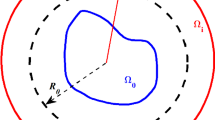Abstract
The pseudopotential and perturbation theory are used to derive the first three terms in the expansion of the smallest eigenvalue of the Helmholtz equation both for infinite two-dimensional systems with an array of perfectly absorbing circles centered on (1) a square lattice and (2) a triangular lattice, and also for infinite three-dimensional systems both with arrays of perfectly absorbing interspersed cylinders and with an array of perfectly absorbing spheres centered on (1), a simple cubic lattice, (2) a body-centered cubic lattice, and (3) a facecentered cubic lattice. In all cases, the perturbation parameter involves the ratio of the radius of the absorber to the lattice spacing. These eigenvalues and the corresponding eigenfunctions are used to compute the first three terms of expansions of the first passage time of a diffusing point particle randomly placed outside the absorbers. Expressing the perturbation parameter as a function of the area or volume fraction occupied by the absorbers reveals a remarkable similarity among the rates of diffusion-limited reaction for arrays of absorbers and the corresponding radially symmetric system containing one central absorber.
Similar content being viewed by others
References
Kerson Huang and C. N. Yang,Phys. Rev. 105:767–775 (1957).
P. M. Morse and H. Feshbach,Methods of Theoretical Physics, Vol. 2 (McGraw-Hill, New York, 1953), p. 1001.
J. R. Lebenhaft and R. Kapral,J. Stat. Phys. 20:25–56 (1979).
B. U. Felderhof,Physica 130A:34–56 (1985).
M. Abramowitz and I. Stegun, eds.,Handbook of Mathematical Functions (U. S. Government Printing Office, Washington, D. C., 1964), p. 360.
R. Courant,Differential and Integral Calculus, Vol. 2 (Blackie, London, 1936), p. 367.
M. V. Berry,Ann. Phys. (N.Y.) 131:163–216 (1981).
Eldon R. Hansen,A Table of Series and Products (Prentice-Hall, Englewood Cliffs, New Jersey, 1975), p. 243.
H. Hasimoto,J. Fluid Mech. 5:317–328.
Linus Pauling and E. Bright Wilson,Introduction to Quantum Mechanics (McGraw-Hill, New York, 1935), p. 165.
Otto Emersleben,Phys. Z. 24:73–80 (1923).
Otto Emersleben,Phys. Z. 24:97–104 (1923).
Rosemary A. Coldwell-Horsfall and Alexei A. Maraudin,J. Math. Phys. 1:395–404 (1960).
Howard C. Berg and Edward M. Purcell,Biophys. J. 20:193–219 (1977).
Lord Rayleigh,Phil. Mag. 34:481–502 (1892).
Harold Levine,J. Inst. Math. Appl. 2:12–28 (1966).
Dikeos Soumpasis,J. Chem. Phys. 69:3190–3196 (1978).
G. N. Watson,A Treatise on the Theory of Bessel Functions, 2nd ed. (University Press, Cambridge, 1966), p. 388.
I. S. Gradshteyn and I. M. Ryzhik,Table of Integrals, Series and Products (Academic Press, New York, 1980), p. 978.
W. L. Slattery, G. D. Doolen, and H. E. DeWitt,Phys. Rev. A 21:2087–2095 (1980).
Author information
Authors and Affiliations
Rights and permissions
About this article
Cite this article
Torney, D.C., Goldstein, B. Rates of diffusion-limited reaction in periodic systems. J Stat Phys 49, 725–750 (1987). https://doi.org/10.1007/BF01009354
Received:
Revised:
Issue Date:
DOI: https://doi.org/10.1007/BF01009354




